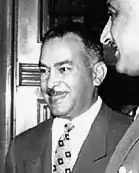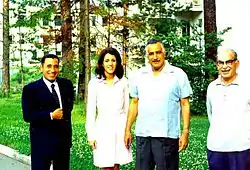Ali Sabri
Ali Sabri (Arabic: على صبرى, IPA: [ˈʕæli ˈsˤɑbɾi]) (30 August 1920[1] – 3 August 1991)[2] was an Egyptian politician of Turkish origin.[3]
Ali Sabri | |
|---|---|
| على صبرى | |
| Vice President of Egypt | |
| In office 3 October 1965 – 20 March 1968 | |
| President | Gamal Abdel Nasser |
| Preceded by | Anwar Sadat |
| Succeeded by | Hussein al-Shafi'i |
| 32nd Prime Minister of Egypt | |
| In office 29 September 1962 – 3 October 1965 | |
| President | Gamal Abdel Nasser |
| Preceded by | Gamal Abdel Nasser |
| Succeeded by | Zakaria Mohieddin |
| Director of the Egyptian General Intelligence Directorate | |
| In office 1956–1957 | |
| President | Gamal Abdel Nasser |
| Preceded by | Zakaria Mohieddin |
| Succeeded by | Salah Nasr |
| Personal details | |
| Born | Ali Sabri 30 August 1920 Cairo, Sultanate of Egypt |
| Died | 3 August 1991 (aged 70) Cairo, Egypt |
| Profession | Aristocrat, Military Officer, Politician, Intelligence Officer |
| Military service | |
| Allegiance | |
| Branch/service | Egyptian Army |
| Rank | Marshal |
Family background
His parents, Dewlet Shamsi (mother) and Abbas-Baligh Sabri (father) were of Turkish-Circassian descent and belonged to the privileged class.
Ali Sabri was a grandson of nationalist Amin Shamsi Pasha (1833-1913) a member of the General Assembly and Provincial Council who in 1881-82 was a principal financial backer of Ahmed Urabi Pasha. Following the failure of what historian term the "Urabi Rebellion" of 1882, Khedive Tewfik imprisoned Shamsi Pasha later releasing him on a hefty bail. He resumed his seat at the General Assembly until his death.
Sabri was also a nephew of Ali Shamsi Pasha (1885-1962) co-founder of the Wafd Party and a several-time minister during the reign of Fuad I of Egypt later to become the first Egyptian to head of the National Bank of Egypt which acted as the country's Central Bank.[4]
One of Ali Sabri's paternal grand-uncles was Mohammed Faizi Pasha (1840-1911), a director-general of the Awqaf Department during the reign of Khedive Abbas Hilmi II.
The trilingual Ali Sabri, along with his three brothers and one sister, was raised in the then-predominantly aristocratic and European Cairo suburb of Maadi and was an active member of its Sporting Club's tennis and swimming teams.[5]
Egyptian revolution and premiership

Sabri was one of the second row of 1952 revolution officers, he was the head of Egyptian General Intelligence Directorate from 1956 to 1957. He was the 32nd Prime Minister of Egypt from September 1962 to October 1965.
When Gamal Abdel Nasser died in 1970, Anwar Sadat was regarded as Nasser's most likely successor, but Sabri was regarded as the next most likely. Both Sadat and Sabri had heart attacks which they survived at Nasser's funeral.

Sabri was the vice-president and regarded as the no. 2 figure in Sadat's government. However shortly after Sadat came to power he was the most notable casualty of Sadat's "Corrective Revolution", and was imprisoned.
Regarded as a diehard socialist, he was often criticized for his upper-class background. Ali Sabri died in Cairo on 3 August 1991, aged 70.
Honour
Foreign honour
- Malaysia:
_-_SMN.svg.png.webp) Honorary Grand Commander of the Order of the Defender of the Realm (SMN (K)) - Tun (1965)[6]
Honorary Grand Commander of the Order of the Defender of the Realm (SMN (K)) - Tun (1965)[6]
- Czechoslovak Socialist Republic:
- Order of the White Lion (25 September 1964)[7]
References
- Limited, Eurora Publications (1973). The Middle East and North Africa 1973-74. ISBN 9780900362606.
- "على صبرى فى ذاكرة مصر المعاصرة بمكتبة الإسكندرية". اليوم السابع. 27 November 2014. Retrieved 11 March 2023.
- Goldschmidt, Arthur (2000). Biographical dictionary of modern Egypt. Lynne Rienner Publishers. p. 171. ISBN 1-55587-229-8.
- Privileged for Three Centuries: The House of Shamsy Pasha, Elias Press, Cairo, 2011
- Privileged for Three Centuries: the house of Shamsy Padha, Elias Presx, Cairo, 2011
- "Senarai Penuh Penerima Darjah Kebesaran, Bintang dan Pingat Persekutuan Tahun 1965" (PDF). Archived from the original (PDF) on 28 September 2018. Retrieved 15 June 2016.
- "Československý řád Bílého lva 1923–1990" (PDF). prazskyhradarchiv.cz (in Czech). 28 January 2015. p. 159. Retrieved 6 May 2023.
External links
 Media related to Ali Sabri at Wikimedia Commons
Media related to Ali Sabri at Wikimedia Commons